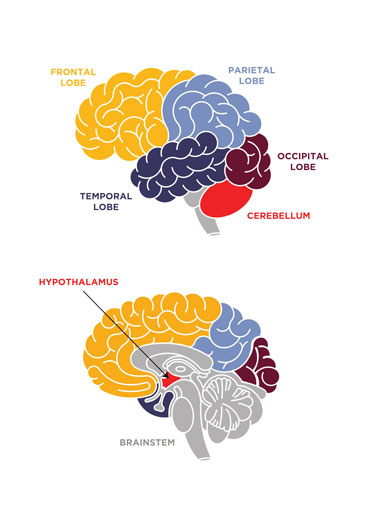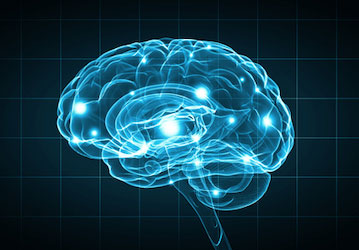Your brain is a Total Force Fitness (TFF) tool, and implementing TFF strategies to improve your performance directly impacts brain health. The connection between your body and brain goes both ways: Your brain controls all your body functions and receives information about the state of your body. Behaviors that improve your physical health also impact your brain and boost your cognitive performance. So, what's cognitive performance? Cognition is your ability to think, learn, focus, solve problems, make decisions, plan, manage information, and control your feelings and behaviors. This article takes you on a tour of how your brain controls cognition, emotion, and behavior and examines how you can partner with physiology to optimize your performance.
Imagine that you’re on a mission to rescue a hostage. Your goal is to keep everyone safe and alive in a stressful situation that involves shoot or no-shoot decisions. With this scene in mind, take a quick tour of your central nervous system—and particularly your brain—to understand how different brain parts contribute to optimal performance in this situation.
Your brain is the organ inside your skull and comprises the brainstem, 4 different lobes—occipital, parietal, temporal, and frontal—the cerebellum, and the hypothalamus. Here's how each part connects with the others to control vital body functions that can impact performance
Brainstem
 Your brainstem is responsible for controlling your heartbeat, breathing, and blood pressure. It also controls the activity of the autonomic nervous system—both the sympathetic and parasympathetic branches—in response to internal and external changes. For most people, experiencing the event described above is stressful and leads to the activation of the sympathetic nervous system. As a result, your heart rate increases, adrenaline is released, and a generalized state of arousal takes place. In situations like this one, taking deep, slow breaths prompts your brainstem to activate the parasympathetic nervous system to slow down your heart rate and promote relaxation.
Your brainstem is responsible for controlling your heartbeat, breathing, and blood pressure. It also controls the activity of the autonomic nervous system—both the sympathetic and parasympathetic branches—in response to internal and external changes. For most people, experiencing the event described above is stressful and leads to the activation of the sympathetic nervous system. As a result, your heart rate increases, adrenaline is released, and a generalized state of arousal takes place. In situations like this one, taking deep, slow breaths prompts your brainstem to activate the parasympathetic nervous system to slow down your heart rate and promote relaxation.
Everything you do impacts your brain, and health-promoting behaviors that include exercise, breathing and relaxation techniques, and restful sleep also improve your brain health.
Occipital lobe
The occipital lobe receives information from your eyes and is actively involved in seeing. While your eyes scan the scene over and over, the occipital lobe processes information about color, size, depth, and movement and constructs the 3-dimensional image that you perceive. This brain region will help you estimate the distance between the captor and the hostage, estimate the speed of any movement that might happen, and detect facial expressions that will be processed and recognized somewhere else in your brain.
Parietal lobe
The parietal lobe is another region that helps you situate yourself in the scene. It receives information about touch, pain, temperature, and body positioning and puts all the pieces together to help you create a mental picture of your body in the environment. It's important for mapping the environment around you and preventing tripping on obstacles. The parietal lobe helps you to know the positioning of your hands in relation to your body even if you’re not looking at them. It's a critical region of the brain when you have to pay attention to what’s happening around you and still be aware of your hands since you might need to shoot at any time.
This brain region is also essential for the integration of sensory information and coordination of body movement. Information from the parietal lobe is used by the brain regions that control movement for precision. It's vital for learning motor skills and reducing errors as you continue to practice.
Temporal lobe
Your temporal lobe is responsible for many different functions in this hypothetical scenario. First, it’s the brain region that allows you to hear and locate the source of the sound. It helps you identify when someone is walking behind you without moving your head and gaze. If conversations happen during the mission, the temporal lobe is involved as well. This region also plays a role in speech production and comprehension and language recognition.
Face recognition also happens in the temporal lobe. This brain region helps you detect a human face, "read" their emotions, and anticipate their behavior based on their facial expressions. This ability is another very relevant function for optimal performance in the hostage-situation scenario.
Your memories come in handy too. Remembering what you learned in a training session or what you did in a previous similar situation can help you successfully accomplish your mission. The temporal lobe is critical for forming memories and remembering them later. Within the temporal lobe, a region called hippocampus is particularly key for learning and memory. Exercise directly improves hippocampus function and boosts memory and learning.
Your amygdala is another region located in the temporal lobe that’s very important for the overall performance in this hypothetical scenario. It detects actual or potential threats and is responsible for triggering fear and anxiety responses. The amygdala connects with the brainstem and helps initiate the bodily responses needed to respond to threats. It also helps to assign an emotional value to specific memories. That's why some people might feel anxious when they think about past stressful experiences.
Frontal lobe
All this information about sight, hearing, body positioning, face recognition, past memories, and your own emotional state will come together in the frontal lobe and help inform your course of action. The frontal lobe is the front part of your brain. This brain region sets the human advantage over other mammals and primates and is responsible for complex processes such as reasoning, planning, organizing, decision-making, attention-shifting, emotional regulation, and social functioning. Every time you perform a task that requires the combination of information, your frontal cortex is involved. Shoot or no-shoot decision-making is a complex process that involves reasoning while actively gathering information from the environment and other people involved in the scene. Tactical breathing can help you reduce overall arousal and focus attention on vital tasks.
The frontal lobe is also crucial for other basic tasks of day-to-day functioning such as planning an action in a logical order, organizing information and ideas, thinking about emotions, controlling feelings, and executing behavior. Indeed, the areas responsible for body movement are also located in the frontal lobe. Neurons from those areas send information to muscles in your body to perform specific actions. The decision and command to pull the trigger or move towards the hostage, for example, will come from your frontal lobe. It's true that you can't think properly when you don't sleep well, and getting adequate sleep is critical for optimal frontal-lobe function.
Cerebellum
Your cerebellum sits in the back of the brainstem and controls posture and balance, which are essential for optimum performance in this hypothetical scenario too. Tripping while trying to slowly move could result in a disaster, and your cerebellum keeps that from happening. When it’s time to take action, your cerebellum will help to control movement. Actions initiated by the motor cortex are fine-tuned by the cerebellum to ensure coordination, precision, and accurate timing.
Hypothalamus
Last but not least, it's important to mention the hypothalamus, a tiny but powerful structure that connects your brain to the endocrine system. Among other things, your hypothalamus activates the hypothalamus-pituitary-adrenal (HPA) axis, which results in the release of cortisol, a stress hormone. Adequate sleep, deep breathing, progressive relaxation, and exercise are effective ways to reduce cortisol levels and optimize stress so you can perform your best when called to action.
Bottom line
Your brain combines information from different regions and your body to ensure you work at peak performance. Everything you do impacts your brain, and adopting health-promoting behaviors also improves your brain health. In the end, a healthy brain equals improved performance regardless of your specific occupation.
If you haven’t yet done so, read Part 1 in this series for an overview of the nervous system. Part 3 explores the different neurotransmitter systems and identifies healthy ways to promote adequate levels of those chemicals in your brain.
